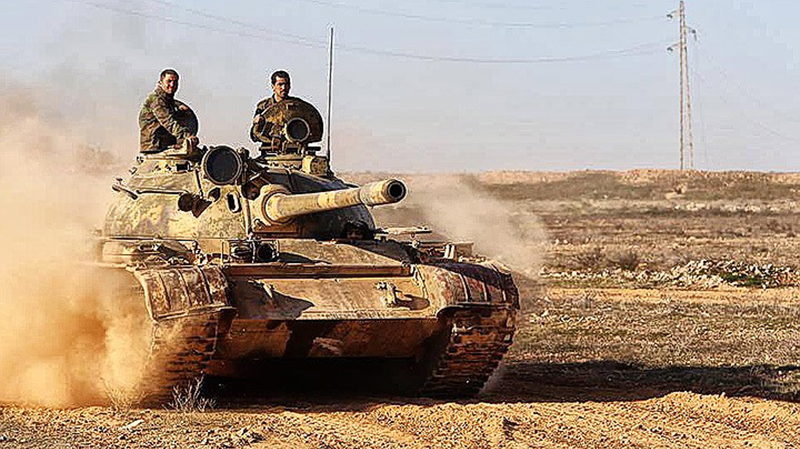
Original by Aleksandr Kots and Dmitriy Steshin published by Komsomolskaya Pravda; translation by J.Hawk
Non-descript guys are carefully climbing into an aged T-55 and take up their respective crew positions. They are clad in civilian clothes or mis-matched camouflage or construction overalls. The vehicle, sorely tested by the war and long service life, reluctantly comes to life and spews a cloud of black smoke. Two days of training, and they’ll ride their tanks into battle. Some of them have served in tank troops, with other armored vehicles, or artillery. The remainder are former drivers, tractor operators, construction workers. The Bukhamat detachment of the Ashiri tribe, which is scattered along the Euphrates River in Raqqa Province, is moving up to the front lines crossing the invisible boundary of Homs Province and heading toward ISIS “capital”, Raqqa which is only 50km distant.
Though it is unlikely that distance will be covered quickly. The militants have prepared a mobile defense, consisting of powerful fortified areas located every 500m of the road. If forced to retreat, the Islamists will try to hold every square kilometer of this lifeless desert.


Government forces have similar fortified areas between Salamiya and Khanaser.
–We control territory out to 5km to the left and right of the road–General Muhammed Deeb, who is responsible for this sector of the front, shows me the jagged outlines of fortified areas on the map. Al Nusra to one side, Daesh to the other. Right now this is the only “lifeline” by which one can travel from Homs to Aleppo. But it’s not recommended to use it at night. Terrorists often launch night-time raids toward the road.
We realized that even before we met the general. The road’s shoulder is littered by dozens of burned out vehicles and buses. After the large field camp whose tents shelter militiamen from Damascus, Hama, Homs, and Raqqa provinces, the road to Aleppo turns East, toward the desert. This is the most important intersection of the road, comparable to Dubosekovo which was defended against the Wehrmacht during its offensive toward Moscow. We keep driving straight ahead, onto the territory which has long been covered ISIS-red on newspaper-published maps. On the way we pass a tank with newly formed crew which is quickly finishing fixing something in its engine.
Visibility is unlimited. With powerful optics, one can see the militants prepare to repel government attacks. Tractors are digging in artillery pieces, pick-up trucks with anti-aircraft guns are hiding behind hillocks, the scouts noted two Abrams tanks 10km from here. They are a “gift” from Iraq, captured by the Islamists from Iraqi forces. Most of ISIS supplies on this sector of the front come from Iraq. Kurdish forces have almost cut off ISIS from the border with Turkey. The Syrian Arab Army is pushing them westward, away from Aleppo. From the South, the attack is led by a heterogeneous militia and international volunteers. One can find Hezbollah Lebanese, Palestinians, and even Khazara fighters from Afghanistan. At first we couldn’t figure out who they were. They are all short, with slanted eyes and child-like facial features. They look more like boy scouts from an Asian pioneer camp, but they already have fighting in Hama and Aleppo provinces under their belts.

One of the fighters who somehow looks like youthful Bruce Lee, speaks English with difficulty. I’m not sure we understood one another:
–Why are you helping Syrian army?
–Because the Syrian army is good–he flashes a boyish smile. So far ISIS is far away, we don’t see them.
–Where do you live in Afghanistan?
–I am from Kabul and my comrades from various provinces, from all over the country.
The fighters from Kabul and Mazar-i-Sharif conduct prayers before the battle.

In the meantime, the newly-minted and visibly nervous tankers from the Bedouin Ashiri tribe are driving out to the front lines. This is their first attack, and each tank has only 7 shells. Islamist positions are generously pounded by Grads, which cover the entire fortified area. That somewhat improves the tankers’ mood. The tanks drive into open terrain and head straight for ISIS positions. It doesn’t look nearly as epic as the tank battle in “Liberation”, as there are only three tanks, two of which are crewed by novices. But these former tractor-men have learned something in two days. Deploying into a line, they fire into militant fortifications which reply with large-caliber machine-gun fire. A pick-up armed with an anti-aircraft gun drives out in front of the tanks and remains unnoticed by the militiamen. But the Islamists don’t fire–either the weapon jammed or the Islamists decided not to engage these more powerful vehicles, and the pick-up disappears behind the hillock.
The tanks set up a so-called “carousel”, coming out of a low depression one at a time. After an hour of unhurried fighting at considerable ranges, we see pick-ups with infantry raise dust over the desert in order to occupy the abandoned positions. It means that the Syrian army liberated another 10 square kilometers of its country. We were told it has advanced 9 kilometers into enemy-held territory.







Excellent article, thank you.
Good article and great men…